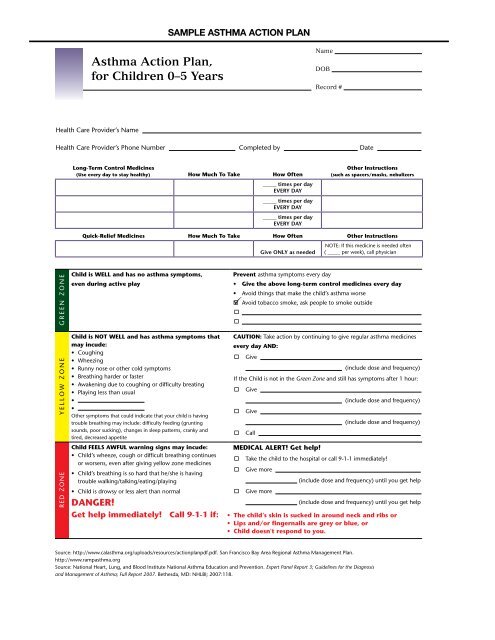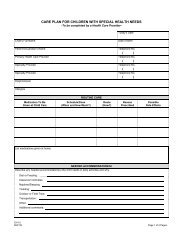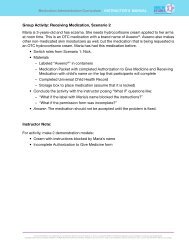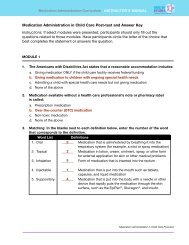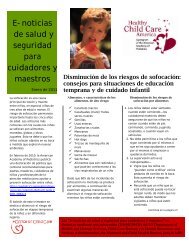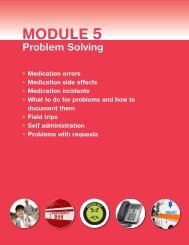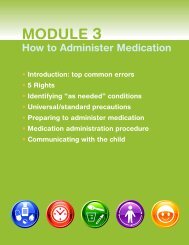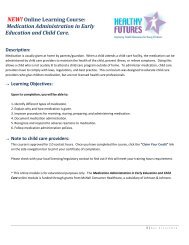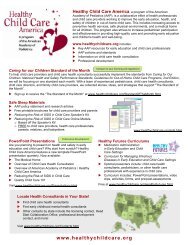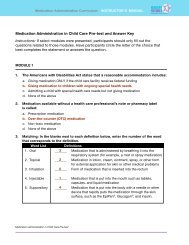Asthma Action Plan, for Children 0–5 Years - Healthy Child Care ...
Asthma Action Plan, for Children 0–5 Years - Healthy Child Care ...
Asthma Action Plan, for Children 0–5 Years - Healthy Child Care ...
You also want an ePaper? Increase the reach of your titles
YUMPU automatically turns print PDFs into web optimized ePapers that Google loves.
SAMPLE ASTHMA ACTION PLAN<br />
<strong>Asthma</strong> <strong>Action</strong> <strong>Plan</strong>,<br />
<strong>for</strong> <strong><strong>Child</strong>ren</strong> 0–5 <strong>Years</strong><br />
Name<br />
DOB<br />
Record #<br />
Health <strong>Care</strong> Provider’s Name<br />
Health <strong>Care</strong> Provider’s Phone Number Completed by .Date<br />
Long-Term Control Medicines<br />
(Use every day to stay healthy) How Much To Take How Often<br />
_____ times per day<br />
EVERY DAY<br />
_____ times per day<br />
EVERY DAY<br />
_____ times per day<br />
EVERY DAY<br />
Other Instructions<br />
(such as spacers/masks, nebulizers<br />
Quick-Relief Medicines How Much To Take How Often Other Instructions<br />
Give ONLY as needed<br />
NOTE: If this medicine is needed often<br />
( _____ per week), call physician<br />
GREEN ZONE<br />
YELLOW ZONE<br />
RED ZONE<br />
<strong>Child</strong> is WELL and has no asthma symptoms,<br />
even during active play<br />
<strong>Child</strong> is NOT WELL and has asthma symptoms that<br />
may incude:<br />
• Coughing<br />
• Wheezing<br />
• Runny nose or other cold symptoms<br />
• Breathing harder or faster<br />
• Awakening due to coughing or difficulty breating<br />
• Playing less than usual<br />
•<br />
•<br />
Other symptoms that could indicate that your child is having<br />
trouble breathing may include: difficulty feeding (grunting<br />
sounds, poor sucking), changes in sleep patterns, cranky and<br />
tired, decreased appetite<br />
<strong>Child</strong> FEELS AWFUL warning signs may incude:<br />
• <strong>Child</strong>’s wheeze, cough or difficult breathing continues<br />
or worsens, even after giving yellow zone medicines<br />
• <strong>Child</strong>’s breathing is so hard that he/she is having<br />
trouble walking/talking/eating/playing<br />
• <strong>Child</strong> is drowsy or less alert than normal<br />
DANGER!<br />
Get help immediately! Call 9-1-1 if:<br />
Prevent asthma symptoms every day<br />
• Give the above long-term control medicines every day<br />
• Avoid things that make the child’s asthma worse<br />
<br />
Avoid tobacco smoke, ask people to smoke outside<br />
<br />
<br />
CAUTION: Take action by continuing to give regular asthma medicines<br />
every day AND:<br />
<br />
Give<br />
(include dose and frequency)<br />
If the <strong>Child</strong> is not in the Green Zone and still has symptoms after 1 hour:<br />
<br />
<br />
<br />
Give<br />
Give<br />
Call<br />
MEDICAL ALERT! Get help!<br />
<br />
<br />
<br />
(include dose and frequency)<br />
(include dose and frequency)<br />
Take the child to the hospital or call 9-1-1 immediately!<br />
Give more<br />
Give more<br />
(include dose and frequency) until you get help<br />
(include dose and frequency) until you get help<br />
• The child’s skin is sucked in around neck and ribs or<br />
• Lips and/or fingernails are grey or blue, or<br />
• <strong>Child</strong> doesn't respond to you.<br />
Source: http://www.calasthma.org/uploads/resources/actionplanpdf.pdf. San Francisco Bay Area Regional <strong>Asthma</strong> Management <strong>Plan</strong>.<br />
http://www.rampasthma.org<br />
Source: National Heart, Lung, and Blood Institute National <strong>Asthma</strong> Education and Prevention. Expert Panel Report 3; Guidelines <strong>for</strong> the Diagnosis<br />
and Management of <strong>Asthma</strong>; Full Report 2007. Bethesda, MD: NHLBI; 2007:118.
Patient Name<br />
DOB<br />
<strong>Asthma</strong> <strong>Action</strong> <strong>Plan</strong>, <strong>for</strong> <strong><strong>Child</strong>ren</strong> 0 – 5 <strong>Years</strong>, continued<br />
PROVIDER INSTRUCTIONS FOR ASTHMA ACTION PLAN (<strong><strong>Child</strong>ren</strong> ages 0-5)<br />
Determine the Level of <strong>Asthma</strong> severity (see Table 1)<br />
Fill In Medications<br />
Fill in medications appropriate to that level (see Table 1) and include<br />
instructions, such as “shake well be<strong>for</strong>e using” “use with spacer”,<br />
and “rinse mouth after using”.<br />
Address Issues Related To <strong>Asthma</strong> Severity<br />
These can include allergens, smoke, rhinitis, sinusitis, gastroesophaegeal<br />
reflux, sulfite sensitivity, medication interactions,<br />
and viral respiratory infections.<br />
Fill in and Review <strong>Action</strong> Steps<br />
Complete the recommendations <strong>for</strong> action in the different zones,<br />
and review the whole plan with the family so they are clear on how to<br />
adjust the medications, and when to call <strong>for</strong> help.<br />
Distribute copies of the plan<br />
Give the top copy of the plan to the family, the next one to school, day care,<br />
caretaker, or other involved third party as appropriate, and file the last copy<br />
in the chart.<br />
Review <strong>Action</strong> plan Regularly (Step Up/Step Down Therapy)<br />
A patient who is always in the green zone <strong>for</strong> some months may be a candidate to<br />
“step down” and be reclassified to a lower level of asthma severity and treatment.<br />
A patient frequently in the yellow or red zone should be assessed to make sure<br />
inhaler technique is correct, adherence is good, environmental factors are not interfering<br />
with treatment, and alternative diagnoses have been considered. If these<br />
considerations are met, the patient should “step up” to a higher classification of<br />
asthma severity and treatment. Be sure to fill out a new asthma action plan when<br />
changes in treatment are made.<br />
TABLE 1 SEVERITY AND MEDICATION CHART (Classification is based on meeting at least one criterion)<br />
Severe Persistent Moderate Persistent Mild Persistent Mild Intermittent<br />
Symptoms/Day Consistent symptoms Daily symptoms > 2 days/week but < 1 time/day ≤ 2 days/week<br />
Symptoms/Night Frequent > 1 night/week > 2 nights/month ≤ 2 nights/month<br />
Long Term<br />
Control 1<br />
Quick Relief 1<br />
Preferred treatment:<br />
• Daily high-dose inhaled<br />
corticosteroid<br />
AND<br />
• Log acting inhaled<br />
B 2<br />
– agonist<br />
AND, if needed:<br />
• Corticosteroid tablets or<br />
syrup long term<br />
(2 mg/kg/day, generally do<br />
not exceed 60 mg per day).<br />
(Make repeated attempts to<br />
reduce systemic corticosteroids<br />
and maintain control<br />
with high-dose inhaled<br />
corticosteroids.)<br />
Consultation With <strong>Asthma</strong><br />
Specialist Recommended<br />
Preferred treatment:<br />
• Inhaled short-acting<br />
B 2<br />
– Agonist<br />
Alternative treatment:<br />
• Oral B 2<br />
– agonist<br />
Preferred treatment:<br />
• Daily low dose inhaled<br />
corticosteroid and long-acting<br />
inhaled B 2<br />
– agonist<br />
OR<br />
• Daily medium-dose inhaled<br />
corticosteroid<br />
Alternative treatment:<br />
• Daily low-dose inhaled<br />
corticosteroid and either<br />
leukotriene receptor<br />
antagonist or theophylline<br />
If needed (particularly in<br />
patients with recurring severe<br />
exacerbations):<br />
Preferred treatment:<br />
• Daily medium dose inhaled<br />
corticosteroid and long-acting<br />
inhaled B 2<br />
– agonist<br />
Alternative treatment:<br />
• Daily medium-dose inhaled<br />
corticosteroid and either<br />
leukotriene receptor<br />
antagonist or theophylline<br />
Consultation With <strong>Asthma</strong><br />
Specialist Recommended<br />
Preferred treatment:<br />
• Inhaled short-acting<br />
B 2<br />
– Agonist<br />
Alternative treatment:<br />
• Oral B 2<br />
– agonist<br />
Preferred treatment:<br />
• Daily low dose inhaled<br />
corticosteroid (with nebulizer<br />
or MDI with holding chamber<br />
with or without face mask<br />
or DPI)<br />
Alternative treatment:<br />
• Cromolyn (nebulizer is preferred<br />
or MDI with holding<br />
chamber)<br />
OR<br />
• Leukotriene receptor<br />
antagonist<br />
Note: Initiation of long-term<br />
controller therapy should be<br />
considered if child has had<br />
more then three episodes of<br />
wheezing in the past year that<br />
lasted more than one day and<br />
affected sleep and who have<br />
risk factors <strong>for</strong> the development<br />
of asthma 2<br />
Consultation With <strong>Asthma</strong><br />
Specialist Recommended<br />
Preferred treatment:<br />
• Inhaled short-acting<br />
B 2<br />
– Agonist<br />
Alternative treatment:<br />
• Oral B 2<br />
– agonist<br />
NO daily medication needed.<br />
Preferred treatment:<br />
• Inhaled short-acting<br />
B 2<br />
– Agonist<br />
Alternative treatment:<br />
• Oral B 2<br />
– agonist<br />
1<br />
For infants and children use spacer or spacer AND MASK.<br />
2<br />
Risk factors <strong>for</strong> the development of asthma are parental history of asthma, physician-diagnosed etopic dermatitis or two of the following: physician-diagnosed<br />
allergic rhinitis, wheezing apart from colds, peripheral blood eosinophilia. With viral respiratory infection, use bronchodilator every 4-6 hours up to 24 hours<br />
(longer with physician consult); in general no more than once every six weeks. If patient has seasonal asthma on a predictable basis, long-term anti-inflammatory<br />
therapy (inhaled corticosteroids, cromolyn) should be initiated prior to the anticipated onset of symptoms and continued through the season.<br />
This <strong>Asthma</strong> <strong>Plan</strong> was developed by a committee facilitated by the <strong>Child</strong>hood <strong>Asthma</strong> Initiative, a program funded by the Cali<strong>for</strong>nia <strong><strong>Child</strong>ren</strong> and Families Commission,<br />
and the Regional <strong>Asthma</strong> Management and Prevention (RAMP) Initiative, a program of the Public Health Institute. This plan is based on the recommendations<br />
from the National Heart, Lung, and Blood Institute’s. “Guidelines <strong>for</strong> the Diagnosis and Management of <strong>Asthma</strong>.” NIH Publication No. 97-4051 (April 1997) and<br />
“Update on Selected Topics 2002.” NIH Publication No. 02-5075 (June 2002). The in<strong>for</strong>mation contained herein is intended <strong>for</strong> the use and convenience of physicians<br />
and other medical personnel, and may not be appropriate <strong>for</strong> use in all circumstances. Decisions to adopt any particular recommendation must be made by<br />
qualified medical personnel in light of available resources and the circumstances presented by individual patients. No entity or individual involved in the funding<br />
or development of this plan makes any warranty guarantee, express or implied, of the quality, fitness, per<strong>for</strong>mance or results of use of the in<strong>for</strong>mation or products<br />
described in the plan or the Guidelines. For additional in<strong>for</strong>mation, please contact RAMP at (510) 622-4438, http://www.rampasthma.org.


